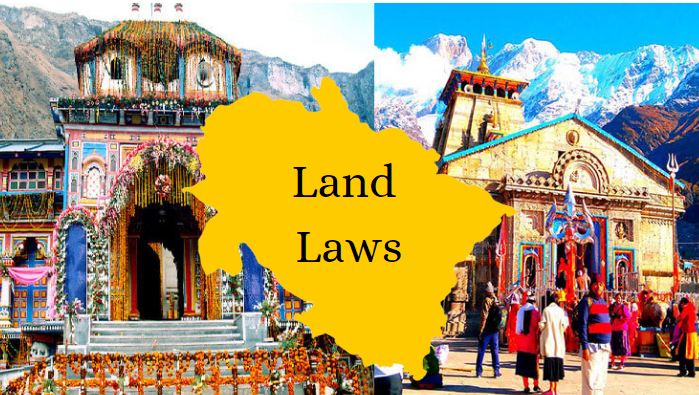The state of Uttarakhand has been traditionally known as ‘devabhoomi’- the state where some of the most ancient temples and holy cities like Kedarnath, Badrinath, Gangotri, Rishikesh and Haridwar is located. Yet, if Uttarakhand has to retain its image as ‘devabhoomi’, it needs strict land laws that prevent encroachment by migrants and non-indigenous communities.
Demand for land laws in Uttarakhand:
Uttarakhand has been witnessing a major campaign for bringing in new and strict land laws. Netizens and the youth of Uttarakhand are running a movement that demands restrictions on land purchases by outsiders.
In the Himalayan state, there is no prohibition on outsiders buying a property or house within municipal limits or cantonment areas of the hill state. There is also no restriction on the area of land that a person from some other state can purchase in the state.
A limit of an area upto 250 square metres on purchasing agricultural land outside municipal limits were introduced by a 2003 law. However, it was set aside in 2018 by the Trivendra Singh Rawat government, paving way for outsiders to purchase any amount of land in Uttarakhand.
However, the locals have been demanding the implementation of a provision like an Article 371 that restricts land purchases by outsiders in northeastern states, Goa and many other states.
In August, the Uttarakhand government stated that it will set up a committee to look into the feasibility of land law in the state.
Why Uttarakhand needs a land law:
Uttarakhand is losing its basic structure as a ‘devabhoomi’. As per an October report published by Dainik Jagran, districts of Udham Singh Nagar, Champawat and Pithoragarh, in the Kumaon region bordering Nepal are facing rapid demographic changes.
As per the 2011 census, the population of a specific religious community registered a 2.5-fold increase. In January 2021, security agencies sent a report to the Home Ministry that described the three districts as vulnerable.
Security agencies also issued an alert regarding the Indo-Nepal border at the Bahraich, Basti and Gorakhpur divisions of Uttar Pradesh, regarding mushrooming of new religious institutions over the past two years.
As per security agencies, the madrasas are opening up in areas that are important from a strategic point of view. DIG Dr Nilesh Anand Bharane said that a warning has been issued to authorities in bordering districts to take precautionary measures.
Uttarakhand’s demographics could change completely:
Parts of Uttarakhand, particularly in Udham Singh Nagar bordering Western Uttar Pradesh are expected to become Muslim-majority regions by 2061. Between 2001 and 2011, Uttarakhand has seen a rather astonishing rise in the share of the Muslim population from 11.9 per cent to 13.9 per cent, a growth of 2 percentage points.
As a matter of fact, the rate of population growth in Uttarakhand’s Haridwar and Udham Singh Nagar – where Muslims form a significant chunk of the population, is double that of the average growth of population in the state.
At a time when the state’s overall decadal growth has been estimated to be around 17 per cent, for three districts with a significant Muslim presence to record abnormally high growth of population points towards the demographic threat which stares Uttarakhand in the eye.
Between 2001 and 2011, the decadal rate of growth in the population of Udham Singh Nagar was a staggering 33.40 per cent. In Dehradun – the state’s capital, the figure stood at 32.48 per cent. In Haridwar, the decadal rate of growth was estimated to be around 33.16 per cent.
The Muslim population growth rate in Uttarakhand is more than that of the Hindu population across most states. Uttarakhand, Kerala, and Haryana are among the larger states where the share of the Muslim population increased by more than 1 per cent.
Recently, TFI reported that recently a video went viral, in which a man could be seen claiming, “Hindus have no knowledge of history…. It is not Badrinath but in the name of Badruddin Shah. Merely adding ‘Nath’ at the end of the name will not convert this place into a religious place for Hindus. It is a holy place for Muslims. It is our religious place; we will go and capture it.”
If Uttarakhand has to preserve its traditional image as a ‘devabhoomi’ with many historic temples that invites pilgrims from all over the country, then it needs strong land laws that help locals conserve their culture and belief. The state needs strong legislation not only in order to protect the interests of its individuals, but also its ancient cultural heritage.
